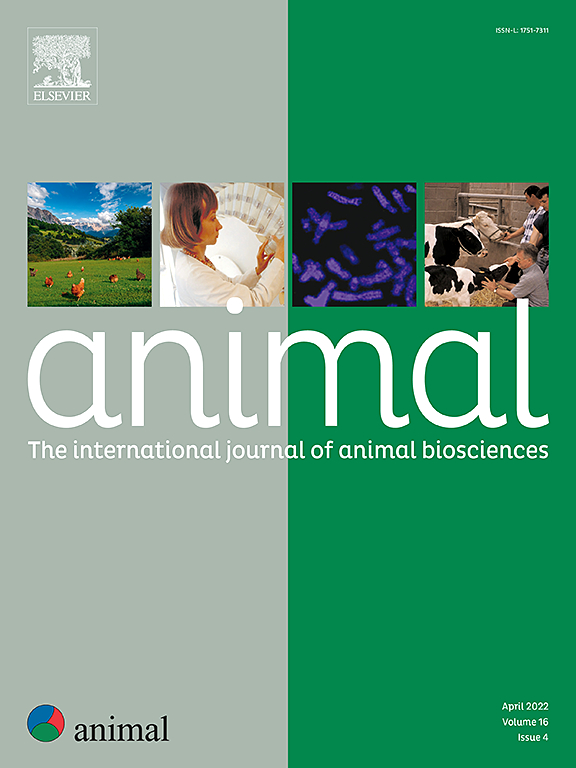红外预测火腿减重的估计育种价值不同品种的猪的火腿减重及其动力学。
IF 4.2
2区 农林科学
Q1 AGRICULTURE, DAIRY & ANIMAL SCIENCE
引用次数: 0
摘要
通过可见-近红外(VIS-NIR)光谱(CWLp)预测火腿的累计减重被认为是间接选择的指示性状,旨在减少火腿的实际减重。但其有效性需要在实践中得到验证。本研究旨在评价在CWLp估计育种值(EBV)上存在差异的两组品种对其后代实际累积减重(CWL)及其在干固化过程中观察到的动态的影响。最终目的是验证CWLp作为指标性状在选择性育种中的应用,以提高干腌火腿的产量。该研究的重点是来自Goland C21纯种系的品种,其育种目标包括与绿火腿质量相关的性状。自2010年以来,屠宰后24小时从单个火腿皮下脂肪中获取VIS-NIR光谱已成为兄弟姐妹检测计划的标准做法。这些数据能够预测绿火腿脂肪品质性状,并自2021年起计算CWLp。从一批70头商用AI C21公猪开始,建立了两组母猪:一组(下组)由15头对CWLp EBV最高的公猪组成,另一组(上组)包括15头EBV最低的公猪。两组随机配种180头杂交母猪。从由此产生的后代中,随机抽取341只个体进行研究,并作为重猪饲养。屠宰后,每头猪的左火腿在干腌过程中称重十倍。比较了7种非线性模型(累积Weibull、Chapman-Richards、负指数、U-Richards、U-Gompertz、U-von Bertalanffy和U-Logistic)来描述个体CWL动态。累积Weibull和Chapman-Richards模型拟合效果最好(R2 = 0.996, RMSE)本文章由计算机程序翻译,如有差异,请以英文原文为准。
Ham weight loss and its dynamics in pigs from sires diverging in estimated breeding value for infrared-predicted ham weight loss
Cumulative ham weight loss predicted through visible-near-infrared (VIS-NIR) spectroscopy (CWLp) is considered an indicator trait for indirect selection aimed at reducing actual ham weight loss. However, its effectiveness needs to be validated in practice. This study aimed to evaluate the effects of two groups of sires, diverging in the estimated breeding value (EBV) for CWLp, on the actual cumulative weight loss (CWL) and its dynamics observed during dry-curing in their progeny. The ultimate goal was to validate the use of CWLp as an indicator trait in selective breeding to enhance dry-cured ham production. The study focused on sires from the Goland C21 purebred line, where the breeding objectives include traits related to green ham quality. Since 2010, acquiring VIS-NIR spectra from individual ham subcutaneous fat 24 h after slaughter has been standard practice in the sib-testing programme. These data enabled the prediction of green ham fat quality traits and, since 2021, the computation of CWLp. Starting from a batch of 70 commercial AI C21 boars, two groups of sires were established: one group (bottom sires) consisting of the 15 boars with the highest EBV for CWLp, and another group (top sires) including the 15 boars with the lowest EBV. These two groups were randomly mated with a total of 180 crossbred sows. From the resulting progeny, a random sample of 341 individuals was selected for the study and raised as heavy pigs. After slaughter, the left ham from each pig was weighed ten times during the dry-curing process. Seven non-linear models (Cumulative Weibull, Chapman-Richards, Negative Exponential, U-Richards, U-Gompertz, U-von Bertalanffy and U-Logistic) were compared to describe the individual CWL dynamics. Cumulative Weibull and Chapman–Richards models showed the best fitting (R2 = 0.996, RMSE < 0.86%), and the Chapman–Richards function was used to estimate individual curves for CWL. Progeny of top sires exhibited a significantly different CWL kinetics, with a decreased rate of CWL compared to the progeny of bottom sires. They also exhibited lower CWL after 12 and 18 months of dry-curing (−2.4 and −2.6%, respectively, P-value < 0.05) and improved green ham quality traits such as subcutaneous fat depth (+4.4%, P-value < 0.05), and marbling and fat depth scores (P-value < 0.001). These findings indicate that selecting breeding candidates for CWLp has the potential to enhance dry-cured ham production.
求助全文
通过发布文献求助,成功后即可免费获取论文全文。
去求助
来源期刊

Animal
农林科学-奶制品与动物科学
CiteScore
7.50
自引率
2.80%
发文量
246
审稿时长
3 months
期刊介绍:
Editorial board
animal attracts the best research in animal biology and animal systems from across the spectrum of the agricultural, biomedical, and environmental sciences. It is the central element in an exciting collaboration between the British Society of Animal Science (BSAS), Institut National de la Recherche Agronomique (INRA) and the European Federation of Animal Science (EAAP) and represents a merging of three scientific journals: Animal Science; Animal Research; Reproduction, Nutrition, Development. animal publishes original cutting-edge research, ''hot'' topics and horizon-scanning reviews on animal-related aspects of the life sciences at the molecular, cellular, organ, whole animal and production system levels. The main subject areas include: breeding and genetics; nutrition; physiology and functional biology of systems; behaviour, health and welfare; farming systems, environmental impact and climate change; product quality, human health and well-being. Animal models and papers dealing with the integration of research between these topics and their impact on the environment and people are particularly welcome.
 求助内容:
求助内容: 应助结果提醒方式:
应助结果提醒方式:


